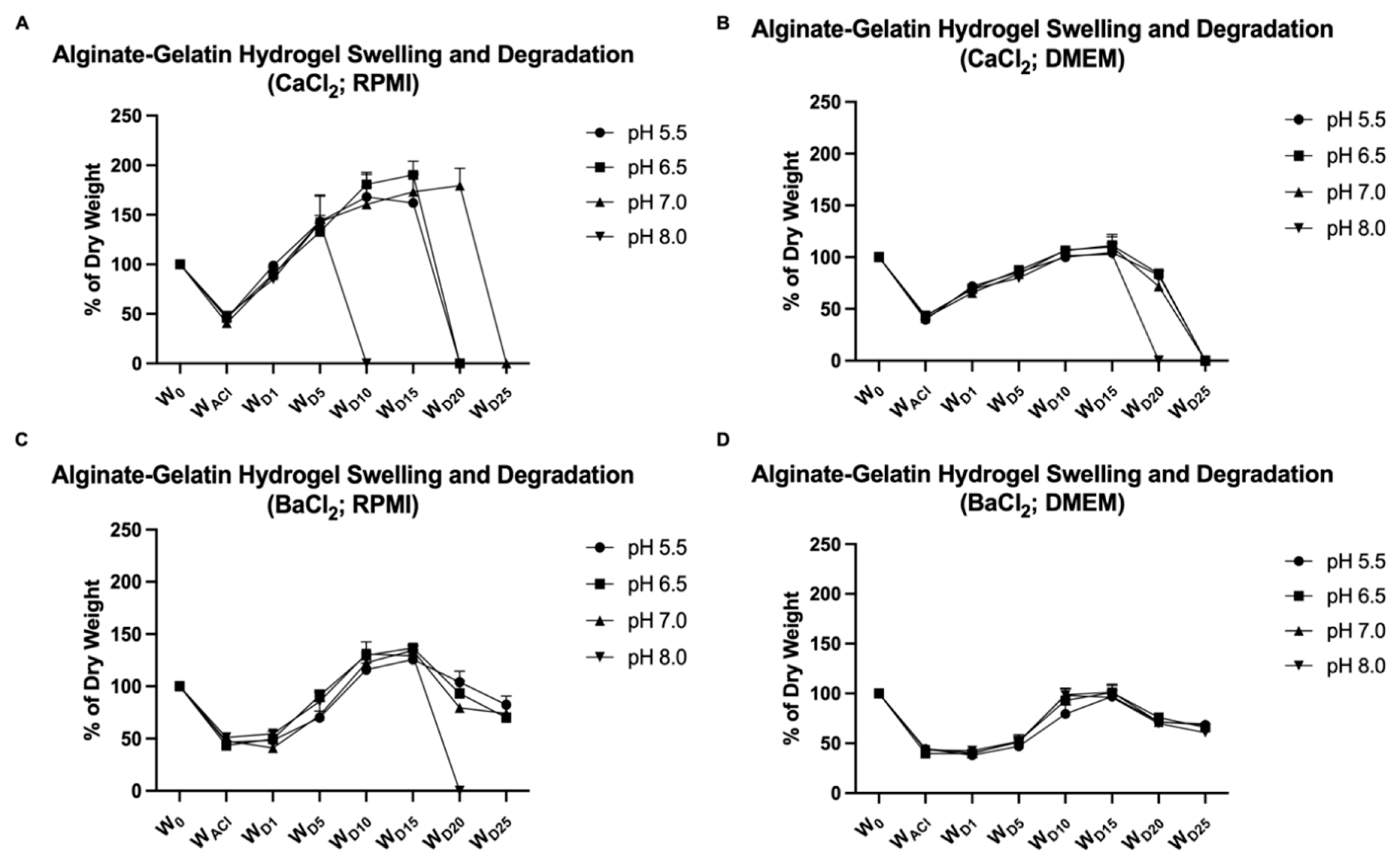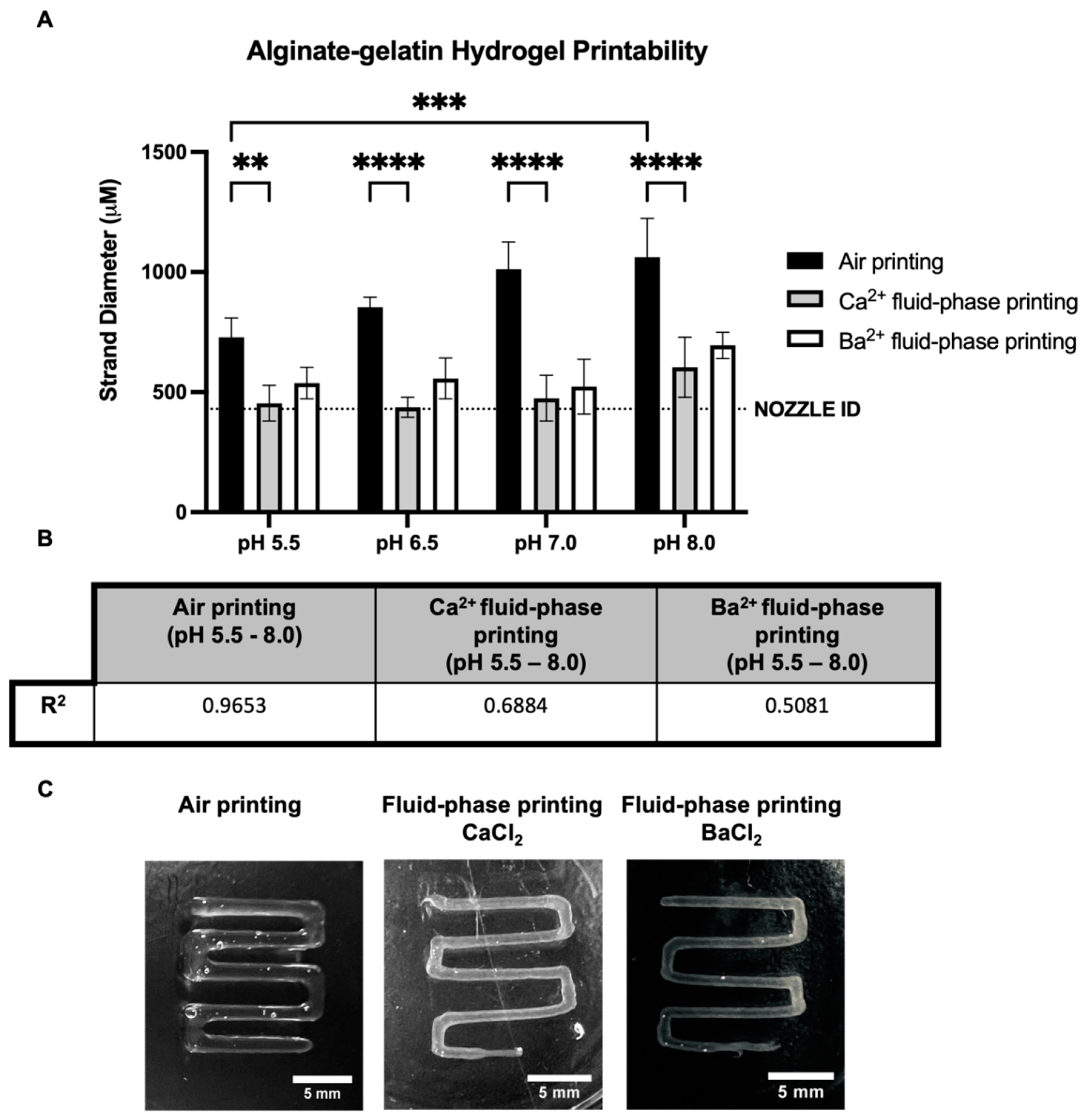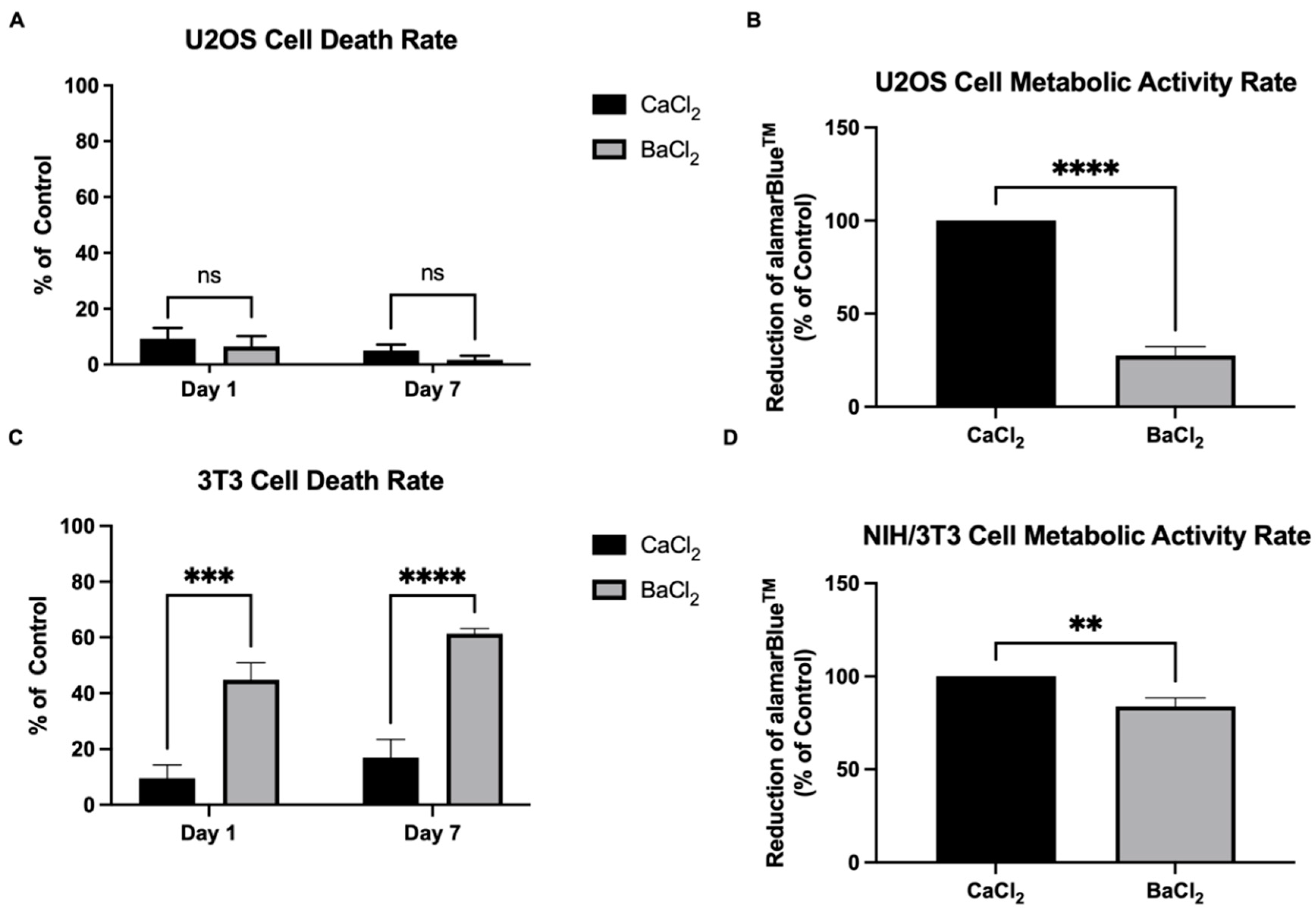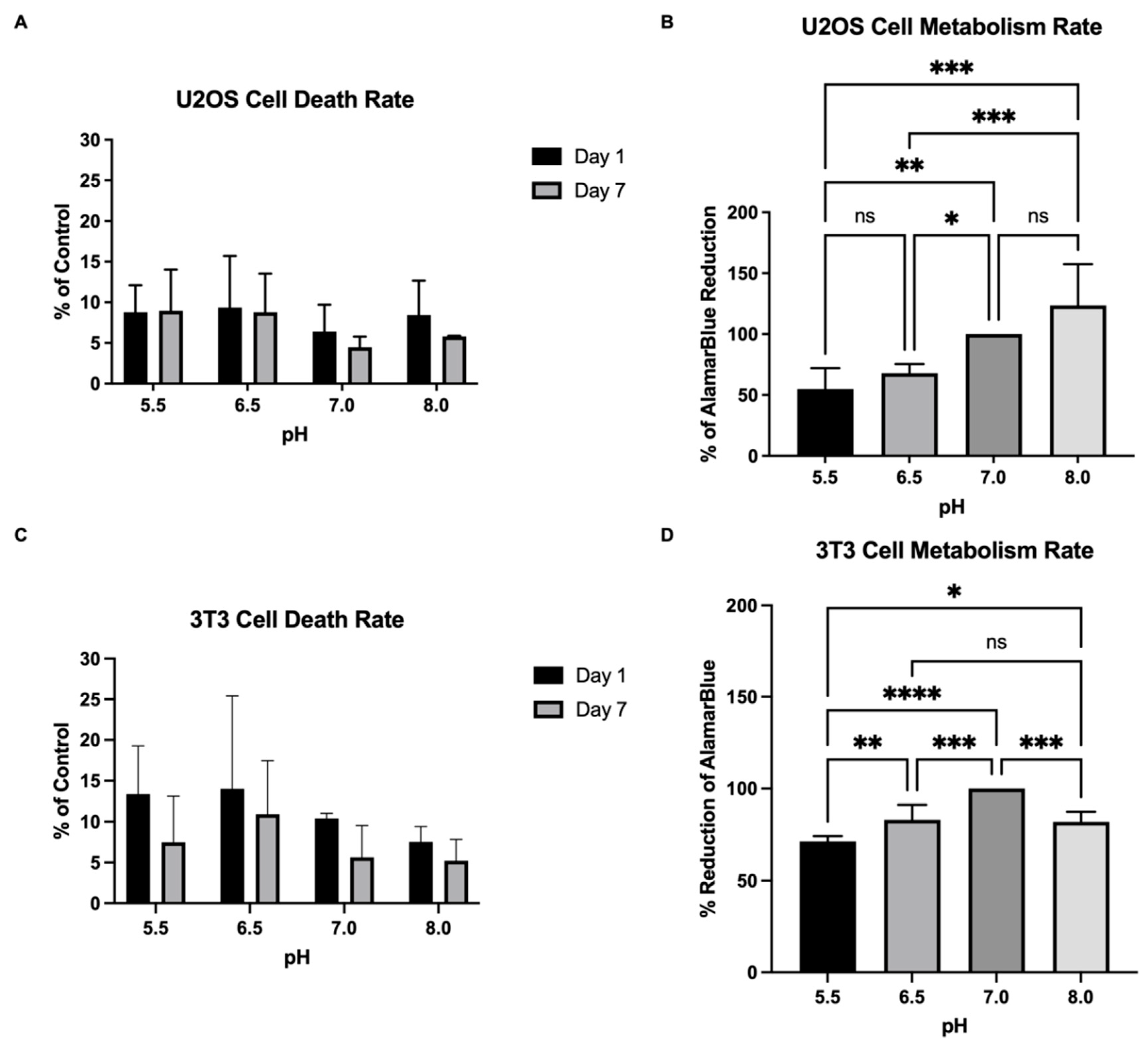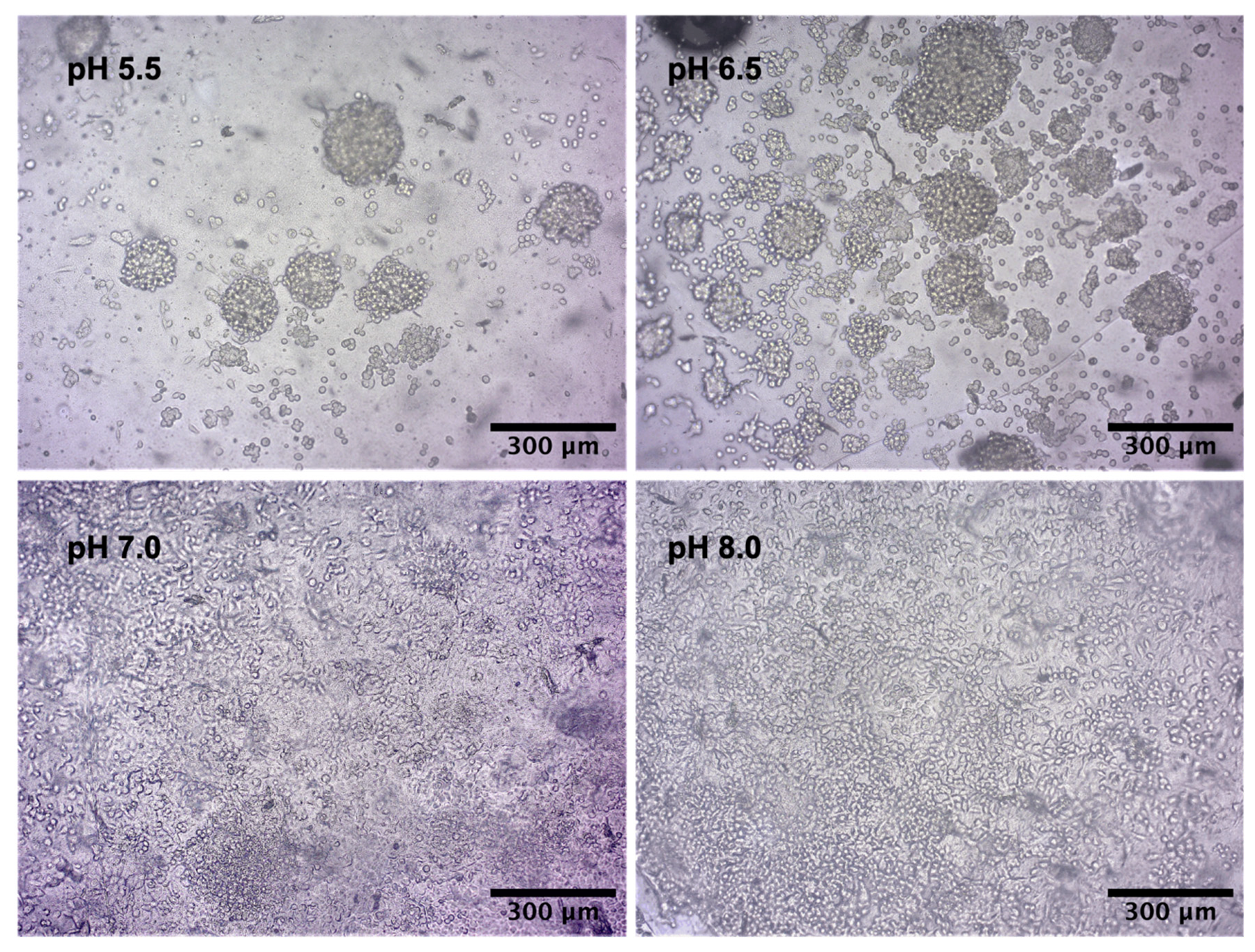1. Introduction
Recently, the 3D (bio)printing technology has shown its potential in replacing and complementing existing methods in basic research, drug delivery and screening, and medical procedures. For instance, it allows the production of bioprinted full skin equivalent and it can support bone and capillary formation, breast fat tissue growth, among other biological structures created in (bio)printed scaffolds
in vitro [
1,
2,
3,
4]. However, even though some important advances have been made to date, this technology is still evolving and in need of more research over the basic requirements needed to create optimal matrices for growing tissues
in vitro. To construct a successful environment, the biological, physical, mechanical, and chemical aspects of the scaffolds should be established specifically to each tissue and/or purpose of the study as pathologic tissues behave differently from healthy ones.
Hydrogels are largely used in the bioengineering field due to their ability to mimic the extracellular environment. Alginate hydrogel is the second most used natural bioink in this field because of its biocompatibility, biomimetic, tunability, good printability, and crosslinkability characteristics [
5]. However, alginate’s highly swollen polymer crosslinked network can lead to instability and degradation just a few days under cell culture conditions [
6]. Therefore, tailoring the alginate into a more biomimetic matrix will make it a more attractive biomaterial. The addition of gelatin can improve the mechanical properties of the hydrogel increasing its elasticity and decreasing its stiffness [
7,
8]. Moreover, Alsberg
et al (2001) has shown that the incorporation of RGD molecules into alginate gels transform the hydrogel in a suitable matrix to promote bone formation [
9]. Finally, an additional way to tailor its mechanical properties is the degree of the crosslinking which can be determine by the crosslinker type, concentration, temperature, time of exposure, etc [
10,
11].
Alginate can be chemically or physically crosslinked. Chemical crosslinking involves the formation of irreversible covalent bonds between alginate chains and leading in general to better stability under cell culture conditions [
12,
13,
14,
15]. Whereas physical crosslinking involves hydrogen bonding, hydrophobic bonding, ionic bonding, electrostatic interactions, etc and create reversible three-dimensional structures [
13,
14,
15,
16]. Alginate is usually ionically crosslinked in the bioengineering field by divalent cations in particular calcium. However, the Ca
2+ molecules from the crosslinked hydrogel can be released to the medium causing inflammatory responses
in vitro and
in vivo [
17]. Another possibility of ionic crosslinking of alginate substrates for cell-based therapies is the use of Ba
2+ molecules. Barium has better affinity to alginate, therefore provides hydrogels with stronger mechanical properties and increased young’s modulus in comparison to calcium [
18]. Yet Ba
2+ has shown diverse effect on cell viability and proliferation depending on the cell type. For instance, Luca
et al (2007) reported that encapsulated Sertoli cells in alginate microbeads showed greater viability after barium crosslinking in comparison to calcium [
19]. Whereas Mores
et al (2015) showed a decrease of mononuclear phagocyte viability caused by apoptosis due to barium crosslinking [
20]. Therefore, as few studies about barium crosslinking are available in the literature, the alginate crosslinking with barium should be studied carefully for each cell type and condition.
Another important aspect during the preparation of hydrogel scaffolds for bioengineering is the pH of the solution. FitzSimons
et al (2022) described that the pH influences the polymers bonding kinetics, the mechanical properties, and the protein release of PEG hydrogels crosslinked via reversible thia-Michael addition [
21]. Besides, the pH is involved in regulating the solubility of alginate/gelatin in aqueous phase [
22]. Bouhadir
et al (2001) showed that increasing the pH leads to an increase of the alginate hydrogel degradability [
23]. In addition, the alginate hydrogels viscosity increases with the decrease of the pH reaching to a maximum viscosity at pH 3.0 – 3.5 once the carboxylate groups present in the alginate chain protonate and form hydrogen bonds [
15]. Recently the effect of pH on hydrogels has been largely studied specially regarding the production of responsive hydrogels used to deliver drugs or optimize cell growth and differentiation. Tailoring the hydrogel’s mechanical properties, degradation rate, and affinity to proteins via pH changes is a costless and important tool for the bioengineering field. Therefore, understanding the effect of the hydrogel’s intrinsic pH as well as the surrounding pH on the hydrogel’s mechanics and kinetics is fundamental to control accurately the hydrogel behaviour.
In this work we used a hydrogel composed of 6% alginate and 2% gelatin (w/v) to investigate the impact of different pH values (5.5, 6.5, 7.0, 8.0) and crosslinking ions (CaCl
2, BaCl
2) on the hydrogel stability under cell culture conditions incubated with either DMEM or RPMI 1640. The two media are widely used in cell culture and present differences in their composition regarding calcium (RPMI: 0.8 mM, DMEM: 1.8 mM) and phosphate (RPMI: 5 mM, DMEM: 1 mM) concentrations [
24]. Whereas, both media present physiological pH 7.0 – 7.4. The printability of the alginate-gelatin hydrogel with different pH values were tested in air and under fluid-phase using a support bath containing either 100 mM CaCl
2 or 100 mM BaCl
2. Air printing allows the printability of high viscosity biomaterials and bioinks while the fluid phase printing allows the printability of low viscosity biomaterials and bioinks [
25]. Finally, to broaden our understanding, different cell types (the human osteosarcoma cell line U2OS and the murine fibroblast cell line NIH/3T3) were used to study the effect of the substrate’s pH (as modified by buffer) and crosslinking on cell viability and metabolism.
3. Results
Alginate-gelatin hydrogels were prepared using MES buffer pH of 5.5, 6.5, 7.0 or 8.0 and crosslinked with either 100 mM CaCl
2 or 100 mM BaCl
2 to study the role of the buffer pH and crosslinking on the hydrogel stability over time. With all other factors remaining the same, addition of different pH buffer is expected to change the pH of the hydrogel, hereafter the substrate’s pH. The hydrogels were molded into 10 mm discs and kept under cell culture conditions incubated with either complete RMPI 1640 + 10% FBS or complete DMEM + 10% FBS for 25 days to measure their swelling and degradation rates. As result, we observed that all the conditions presented a weight loss of approximately 50% during the overnight crosslinking with either calcium or barium. However, they regain their initial weight at different speeds. Hydrogels crosslinked with calcium and incubated with RPMI were the least stable under cell culture conditions showing, in general, the fastest degradation rate among all the conditions tested in this work. They regain their initial weight within 24 hours and the swelling of all the hydrogels was between 150 – 200% before degrading (
Figure 1A). The crosslinking with calcium and incubation with DMEM showed better stability in comparison to the previous conditions. The swelling of the samples was around 135% before degradation. However, all the substrates, regardless of their pH, degraded within 25 days under cell culture conditions (
Figure 1B). The crosslinking with barium provided overall good stability to the alginate-gelatin hydrogel. The incubation with RPMI 1640 showed again to promote higher swelling of the samples (~150%) in comparison to the incubation with DMEM (~120%) (
Figure 1C, D). Regarding the hydrogel pH, the hydrogel pH 8.0 presented the weakest stability under cell culture conditions in RPMI regardless of the crosslinking and in DMEM after calcium crosslinking (
Figure 1).
Afterwards, alginate-gelatin hydrogels with different pH values had their printability tested under 3 different conditions: air printing, fluid-phase embedding printing with 100 mM CaCl
2 support bath, and fluid-phase embedding printing with 100 mM BaCl
2 support bath. We have reported in previous findings that to produce printings of the alginate-gelatin hydrogel, the fluid-phase showed to be an efficient way to increase printing fidelity and resolution [
28]. To generate the prints, a needle size 0.43 mm ID was used, and the diameter of the strand spread was measured just after printing for the 3 conditions. First, we observed that the spread of the air printing strand was around 200% while both fluid-phase embedding printings restrained the spread of the printed strand as the hydrogel was immediately crosslinked during printing. In addition, the 2 crosslinker solutions used as support bath showed no significant difference on the spread of the strand between them (
Figure 2A). The pH of the alginate-gelatin hydrogel had a significant influence on the air printing increasing the spread of the printed strand with the increase of the pH. Whereas both embedding fluid-phase cointainging the crosslinkers only showed a slight increase on the spread of the strand with hydrogel pH 8.0 which was not significant (
Figure 2B). The spread of the strand is important for the resolution of the (bio)print and should be calculated and adjusted to obtain the desired printing design. Knowing how the pH of the substrate can influence this aspect and how to overcome it is an important parameter to the biofabrication field. Finally, our results showed that both support bath containing crosslinker (Ca
2+ and Ba
2+) increased the printing fidelity which can be seen especially important at the corners of the prints (
Figure 2C).
Next, we tested the effect of the crosslinking on the cell viability and metabolic activity of the human osteosarcoma U2OS and the murine fibroblast NIH/3T3. Both cell types are well established in the literature and present high cell proliferative rates which made them good models for this study. The U2OS cells did not show significant difference on the cell death rate of cells growing on alginate-gelatin substrates crosslinked with calcium or barium neither on Day 1 nor on Day 7 of cell culture (
Figure 3A). However, the substrate crosslinked with barium led to a 3.62-fold decrease on the U2OS cell metabolic activity in comparison to the substrate crosslinked with calcium (
Figure 3B). In a different manner, NIH/3T3 cells presented a high cell death rate on both Day 1 and Day 7 of cell culture on alginate-gelatin hydrogel crosslinked with barium, 45% and 60% respectively, in comparison to 10% and 20%, respectively, of cell death rate on the same hydrogel crosslinked with calcium (
Figure 3C). Moreover, NIH/3T3 cells also showed less metabolic activity on the substrate crosslinked with barium (83.91%) in comparison to the one crosslinked with calcium (100%) (
Figure 3D). Even though the crosslinking with barium showed better stability to the alginate-gelatin hydrogel, the 2 cell types studied in this work did not show good cell viability and/or cell metabolic activity on substrates crosslinked with Ba
2+.
To study the effect of the substrate pH on cell viability and metabolic activity, U2OS and NIH/3T3 were seeded onto alginate-gelatin prepared with MES buffer of pH 5.5, 6.5, 7.0, and 8.0. Cells were kept in culture for 7 days incubated with complete RPMI +10% FBS (U2OS) or complete DMEM + 10% FBS (NHI/3T3). Our results showed that U2OS cells growing on alginate-gelatin hydrogels prepared with different pH values presented a good cell viability of approximately 90% of viable cells on Day 1 and Day 7 of cell culture. Some cell protective effect was observed by the substrate at pH 7.0, however no significant difference on cell viability was caused by the substrate pH (
Figure 4A). On the contrary, the substrate presenting different pH values led to a significant difference on the cell metabolic activity. Cells growing on substrates prepared with pH 7.0 and 8.0 showed an important increase on the cell metabolism in comparison to cells growing on acidic substrates after 7 days of cell culture. An increase of 2.25 fold was observed on the cell metabolism of cells on substrate pH 8.0 in comparison to cells on the substrate pH 5.5. Even though all the cells were grown in RPMI 1640 cell culture medium under physiological pH. This result shows that it is possible to grow cells over the influence of the pH of interest by preparing a substrate with a specific pH independent of the cell culture medium utilized. In the same way, the NIH/3T3 cells also showed good viability of the cells regardless of the substrate pH values on Day 1 and Day 7 of cell culture (
Figure 4C). However, in the same fashion as U2OS cells, NIH/3T3 also showed significant difference on the cell metabolism due to the substrate pH. NIH/3T3 cells growing on substrate pH 7.0 presented higher metabolic activity in comparison to cells growing on substrates pH 6.5 and 8.0 and even greater cell metabolic activity in comparison to cells growing on substrates pH 5.5 (
Figure 4D).
Finally, we observed that the pH of the substrate also influences the cell-cell and cell-matrix interactions, with cells favouring interactions with each other below pH 7 and the matrix at pH 7 and above. Alginate-gelatin substrates at pH 5.5 and 6.5 led to the formation of cell aggregates, whereas substrates at pH 7.0 and 8.0 showed cells growing more spread out after 7 days of cell culture (
Figure 5).
4. Discussion
Alginate hydrogels can be crosslinked with many divalent cations. In the present study we tested the swelling and degradation rates of alginate-gelatin hydrogels with different pH values after crosslink with either 100 mM CaCl
2 or 100 mM BaCl
2. Both cations are widely used in the biofabrication field to crosslink alginate for different purposes such as drug encapsulation and delivery, wound dressing, tissue formation, etc. Besides, the choice of the crosslinker and its concentration can tailor some of the hydrogel mechanical properties like elasticity, strength, stiffness, swelling, etc [
30]. Haper and Barbut (2014) showed that alginate films crosslinked with BaCl
2 had the highest tensile strength and Young’s modulus among
Ba2+, Ca2+, Mg2+, Sr2+, and Zn2+ while films crosslinked with CaCl
2 had the highest puncture strength [
18]. Alginate’s affinity to divalent cations was shown to decrease with the order: Pb
2+ > Cu
2+ > Cd
2+ > Ba
2+ > Sr
2+ > Ca
2+ > Co
2+, Ni
2+, Zn
2+ > Mn
2+ [
31,
32] and gel strength decreases with decreasing affinity. Our study is in accordance with the literature as barium crosslinking provided better stability for all the tested hydrogels in comparison to calcium crosslinking. Additionally, we observed a shrinkage of approximately 50% on all hydrogels incubated with both crosslinker solutions (CaCl
2 and BaCl
2) for 24h. Saitoh
et al has described a similar effect of alginate hydrogel crosslinked with Ca
2+ and incubated with increasing concentrations of CaCl
2 which showed increasing shrinkage rate. Increasing the binding between Ca
2+ and alginate residual carboxylate groups leads to the increase of the crosslinking degree which facilitates the gel shrinkage [
33]. In the present study we show that Ba
2+ presents similar effect to Ca
2+ regarding the alginate hydrogel shrinkage extent after overnight incubation. Besides the crosslinker effect on the hydrogel, we also showed that the cell culture medium in which the hydrogel is kept also plays an important role as hydrogels incubated with complete DMEM + 10% FBS presented overall better stability over time in comparison to the same hydrogels incubated with complete RPMI 1640 + 10% FBS. Even though both media had the same physiological pH. In addition, among the hydrogels presenting different pH values, the hydrogel at pH 8.0 showed the weakest strength under cell culture conditions in general degrading faster than the hydrogels at pH 5.5, 6.5, and 7.0. Anionic hydrogels such as alginate swell at high pH and shrink at lower pH. The deprotonation of the carboxylic groups of the alginate molecules at high pH decrease the strength of the hydrogel as the negatively charged ions repels each other leading to the hydrogel swelling and fast degradation. In an opposite fashion, acidic media lead to the protonation of alginate carboxylic groups decreasing repulsion and causing the shrinkage because of water loss [
34,
35,
36]. In this study we showed that we can also tailor the alginate hydrogel swelling and degradation/dissociation rates by changing the pH of the solvent used to produce the hydrogel independently of the medium’s pH.
This pH effect was also seen on the printability of the hydrogel as the spread of the strand significantly increased with the increase of the hydrogel pH when printing in air. However, the fluid-phase embedding printing using either 100 mM CaCl
2 or 100 mM BaCl
2 as support baths showed to be efficient to prevent spreading from happening. The slight increase on the spreading of the line of hydrogel pH 8.0 printed in fluid-phase was not significant as the immediate crosslink after printing the hydrogel was sufficient to keep its shape. No significant difference was seen between calcium and barium in relation to the printability of the hydrogel with different pH values. Although, barium support bath showed lower correlation between the spread of the strand and the increasing pH of the hydrogel in comparison to calcium. Jui-Jung
et al (2017) has described that barium crosslinking bath with different pH values does not influence alginate particles shape while the crosslinking with calcium at lower pH values does [
37].
However, even though the crosslinking with barium provided more stability and strength to the alginate-gelatin hydrogel, both U2OS and NIH/3T3 cells showed significantly higher cell metabolic activity on hydrogels crosslinked with calcium in comparison to the hydrogels crosslinked with barium. It was described that both crosslinkers, Ca
2+ and Ba
2+, present a rate of release of molecules to the medium due to their relatively weak ionic interaction and competition with other cations present in the medium. Chan and Mooney (2013) described that alginate crosslinked with calcium releases around 43% of the Ca
2+ incorporated in its meshes within the first 10 hours of incubation with cell culture medium and keep releasing Ca
2+ molecules at a lower rate throughout time as Ca
2+ is slowly exchanged by sodium cations present in the cell culture medium [
17]. While Ba
2+ also presented a high release rate from alginate
in vitro and
in vivo that might be of safety concern [
38]. In addition, it is widely known that Ca
2+ is one of the most important intracellular second messenger participating in an extensive number of cell signalling pathways related to cell adhesion, proliferation, metabolism, apoptosis, etc [
39]. There is a possibility that Ba
2+ ions released from alginate can be competing to Ca
2+ in important metabolic pathways decreasing the metabolic rate of cells seeded onto substrate crosslinked with Ba
2+ [
40,
41,
42]. However, there are few studies over the effect of barium crosslinking on cell activity and metabolism and further investigations should be done for better understanding. We also observed that Ba
2+ crosslinking did not increase cell death in comparison to Ca
2+ crosslinking on U2OS cells, whereas Ba
2+ crosslinking increased the NIH/3T3 cell death rate significantly.
To study the influence of the substrate pH on cell viability and metabolism, U2OS and NIH/3T3 cells were seeded onto substrates with different pH values. Bone cells respond to even slight differences on the environment pH having higher osteoclast activity in acidic pH while osteoblasts have higher activity in basic pH [
43,
44,
45]. This is one of the homeostatic mechanisms to keep the systemic acid-base balance. Matsubara
et al (2013) showed that U2OS cells modulate their proliferation rate in response to the extracellular pH increasing proliferation in higher pH values [
46]. In this work we used the same cell type to investigate if by changing the substrate pH would change cell behaviour. Our results showed that different substrate pH led to a significant difference of cell metabolism and no influence on the cell viability. Corroborating the literature, osteoblasts growing on basic substrate showed greater cell metabolic activity in comparison to cells growing on acidic substrates. Our results, however, showed that independently of the cell culture medium pH, the substrate’s pH played a crucial role on cell behaviour. Besides, we observed that the U2OS cells can modulate the cell arrangement in response to the substrate pH forming aggregates on acidic printings and spready growth on basic printings. Cells start to grow in 3D aggregates when the environment is unfavourable to cell-substrate interactions and lead cells to cell-cell and cell-ECM interactions instead [
47].
Studying the interstitial pH of each tissue is a difficult task. There is no available data for human bone tissue. However, mice embryos were reported to have no impairment on their development in pH between 7.17 and 7.37 [
48]. In this work we used the NHI/3T3 cells which are murine embryonic fibroblasts. It is not reported from which tissue it is originated, but Dastagir
et al (2014) showed that this cell type can differentiate into adipogenic, chondrogenic, and osteogenic lineages [
49]. Our result showed that NHI/3T3 cells had a higher metabolic activity on substrates prepared with a buffer of pH 7.0 in comparison to substrates prepared with pH 5.5, 6.5, and 8.0 even though all the cells were kept In cell culture medium under physiological pH. In addition, the pH of the buffer also did not influence the NHI/3T3 cell viability. Future work in this direction should attempt to directly measure substrate pH as a function of time.
Figure 1.
Alginate-gelatin hydrogel swelling and degradation curve. 6% alginate + 2% gelatin hydrogel prepared with 0.1 M MES buffer pH 5.5, 6.5, 7.0 or 8.0 and crosslinked with either 100 mM CaCl2 or 100 mM BaCl2. The samples were kept under cell culture conditions at 37oC with saturating humidity with either RPMI 1640 + 10% FBS or DMEM + 10% FBS. Hydrogels were dried and weighed after moulded into 10 mm diameter discs (W0= 100%), after crosslinking (WAcl), and on Day 1 (WD1), Day 5 (WD5), Day 10 (WD10), Day 15 (WD15), Day 20 (WD20), and Day 25 (WD25). (A) Hydrogels crosslinked with 100 mM CaCl2 and incubated with RPMI 1640 + 10% FBS. (B) Hydrogels crosslinked with 100 mM CaCl2 and incubated with DMEM + 10% FBS. (C) Hydrogels crosslinked with 100 mM BaCl2 and incubated with RPMI 1640 + 10% FBS. (D) Hydrogels crosslinked with 100 mM BaCl2 and incubated with DMEM + 10% FBS. (n= 4, graph of mean ±SD).
Figure 1.
Alginate-gelatin hydrogel swelling and degradation curve. 6% alginate + 2% gelatin hydrogel prepared with 0.1 M MES buffer pH 5.5, 6.5, 7.0 or 8.0 and crosslinked with either 100 mM CaCl2 or 100 mM BaCl2. The samples were kept under cell culture conditions at 37oC with saturating humidity with either RPMI 1640 + 10% FBS or DMEM + 10% FBS. Hydrogels were dried and weighed after moulded into 10 mm diameter discs (W0= 100%), after crosslinking (WAcl), and on Day 1 (WD1), Day 5 (WD5), Day 10 (WD10), Day 15 (WD15), Day 20 (WD20), and Day 25 (WD25). (A) Hydrogels crosslinked with 100 mM CaCl2 and incubated with RPMI 1640 + 10% FBS. (B) Hydrogels crosslinked with 100 mM CaCl2 and incubated with DMEM + 10% FBS. (C) Hydrogels crosslinked with 100 mM BaCl2 and incubated with RPMI 1640 + 10% FBS. (D) Hydrogels crosslinked with 100 mM BaCl2 and incubated with DMEM + 10% FBS. (n= 4, graph of mean ±SD).
Figure 2.
Alginate-gelatin hydrogel printability. (A) Quantification of the alginate-gelatin hydrogel pH 5.5, 6.5, 7.0 or 8.0 diameter of the strand printed in air and fluid-phase embedding support bath containing either 100 mM CaCl2 or 100 mM BaCl2. (n= 4, Two-way ANOVA, p**<0.01, p***<0.001, p****<0.0001, ns: not significant). (B) R-squared of the effect of increasing pH of alginate-gelatin hydrogel on the spread of the printed line. (C) Alginate-gelatin hydrogel pH 7.0 square wave printing obtained under 3 bars and 1mm/s in air and fluid-phase embedding support bath containing either 100 mM CaCl2 or 100 mM BaCl2.
Figure 2.
Alginate-gelatin hydrogel printability. (A) Quantification of the alginate-gelatin hydrogel pH 5.5, 6.5, 7.0 or 8.0 diameter of the strand printed in air and fluid-phase embedding support bath containing either 100 mM CaCl2 or 100 mM BaCl2. (n= 4, Two-way ANOVA, p**<0.01, p***<0.001, p****<0.0001, ns: not significant). (B) R-squared of the effect of increasing pH of alginate-gelatin hydrogel on the spread of the printed line. (C) Alginate-gelatin hydrogel pH 7.0 square wave printing obtained under 3 bars and 1mm/s in air and fluid-phase embedding support bath containing either 100 mM CaCl2 or 100 mM BaCl2.
Figure 3.
(A) LDH Cytotoxicity Assay of U2OS cells on alginate-gelatin hydrogel pH 7.0 crosslinked with either 100 mM CaCl2 or 100 mM BaCl2 on Days 1 and 7 of cell culture (day 1 n= 4 and day 7 n= 3, Two-way ANOVA, ns: not significant). (B) U2OS metabolic activity rate quantified by the % of alamarBlueTM reduction on Day 7 of cell culture on alginate-gelatin hydrogel pH 7.0 crosslinked with either 100 mM CaCl2 or 100 mM BaCl2 (n= 4, Two-way ANOVA, p****< 0.0001). (C) LDH Cytotoxicity Assay of NIH/3T3 cells on alginate-gelatin hydrogel pH 7.0 crosslinked with either 100 mM CaCl2 or 100 mM BaCl2 on days 1 and 7 of cell culture (n= 3, Two-way ANOVA, p***< 0.001, p****< 0.0001). (D) NIH/3T3 metabolic activity rate quantified by the % of alamarBlueTM reduction on Day 7 of cell culture on alginate-gelatin hydrogel pH 7.0 crosslinked with either 100 mM CaCl2 or 100 mM BaCl2 (n= 4, Two-way ANOVA, p**< 0.01).
Figure 3.
(A) LDH Cytotoxicity Assay of U2OS cells on alginate-gelatin hydrogel pH 7.0 crosslinked with either 100 mM CaCl2 or 100 mM BaCl2 on Days 1 and 7 of cell culture (day 1 n= 4 and day 7 n= 3, Two-way ANOVA, ns: not significant). (B) U2OS metabolic activity rate quantified by the % of alamarBlueTM reduction on Day 7 of cell culture on alginate-gelatin hydrogel pH 7.0 crosslinked with either 100 mM CaCl2 or 100 mM BaCl2 (n= 4, Two-way ANOVA, p****< 0.0001). (C) LDH Cytotoxicity Assay of NIH/3T3 cells on alginate-gelatin hydrogel pH 7.0 crosslinked with either 100 mM CaCl2 or 100 mM BaCl2 on days 1 and 7 of cell culture (n= 3, Two-way ANOVA, p***< 0.001, p****< 0.0001). (D) NIH/3T3 metabolic activity rate quantified by the % of alamarBlueTM reduction on Day 7 of cell culture on alginate-gelatin hydrogel pH 7.0 crosslinked with either 100 mM CaCl2 or 100 mM BaCl2 (n= 4, Two-way ANOVA, p**< 0.01).
Figure 4.
(A) LDH Cytotoxicity assay of U2OS cells on alginate-gelatin hydrogel pH 5.5, 6.5, 7.0, and 8.0 on Days 1 and 7 of cell culture (day 1 n= 4 and day 7 n= 3, Two-way ANOVA, not significant). (B) U2OS metabolic activity rate quantified by the % of alamarBlueTM reduction on Day 7 of cell culture on alginate-gelatin hydrogel pH 5.5, 6.5, 7.0, and 8.0 (n= 6, Two-way ANOVA, p*<0.05, p**<0.01, p***< 0.001, ns: not significant). (C) LDH Cytotoxicity assay of NIH/3T3 cells on alginate-gelatin hydrogel pH 5.5, 6.5, 7.0, and 8.0 on Days 1 and 7 of cell culture (Day 1 n= 3 and Day 7 n= 3, Two-way ANOVA, not significant). (B) NIH/3T3 metabolic activity rate quantified by the % of alamarBlueTM reduction on day 7 of cell culture on alginate-gelatin hydrogel pH 5.5, 6.5, 7.0, and 8.0 (n= 6, Two-way ANOVA, p*<0.05, p**<0.01, p***< 0.001, p****< 0.0001, ns: not significant).
Figure 4.
(A) LDH Cytotoxicity assay of U2OS cells on alginate-gelatin hydrogel pH 5.5, 6.5, 7.0, and 8.0 on Days 1 and 7 of cell culture (day 1 n= 4 and day 7 n= 3, Two-way ANOVA, not significant). (B) U2OS metabolic activity rate quantified by the % of alamarBlueTM reduction on Day 7 of cell culture on alginate-gelatin hydrogel pH 5.5, 6.5, 7.0, and 8.0 (n= 6, Two-way ANOVA, p*<0.05, p**<0.01, p***< 0.001, ns: not significant). (C) LDH Cytotoxicity assay of NIH/3T3 cells on alginate-gelatin hydrogel pH 5.5, 6.5, 7.0, and 8.0 on Days 1 and 7 of cell culture (Day 1 n= 3 and Day 7 n= 3, Two-way ANOVA, not significant). (B) NIH/3T3 metabolic activity rate quantified by the % of alamarBlueTM reduction on day 7 of cell culture on alginate-gelatin hydrogel pH 5.5, 6.5, 7.0, and 8.0 (n= 6, Two-way ANOVA, p*<0.05, p**<0.01, p***< 0.001, p****< 0.0001, ns: not significant).
Figure 5.
Light microscopy images of U2OS cell culture on alginate-gelatin hydrogel pH 5.5, 6.5, 7.0, and 8.0 on Day 7 of cell culture. Magnification of 10x.
Figure 5.
Light microscopy images of U2OS cell culture on alginate-gelatin hydrogel pH 5.5, 6.5, 7.0, and 8.0 on Day 7 of cell culture. Magnification of 10x.
